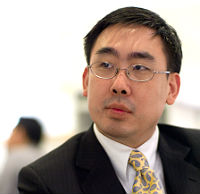When startups are accepted onto the JFDI.Asia business accelerator program, one criteria we judge performance against in the beginning is whether or not they can articulate their Big Vision.
 During week one, teams work with mentors to articulate and challenge their vision. By week four, following sessions on customer discovery and product development, internal sessions take place to revise the startup vision where appropriate.
During week one, teams work with mentors to articulate and challenge their vision. By week four, following sessions on customer discovery and product development, internal sessions take place to revise the startup vision where appropriate.
Knowing Your Vision
Vision is a word that is used a lot but understood only a little. It brings to mind different images in different people, and yet it plays an important role in a company’s success.
In Eric Ries’ The Lean Startup, vision is described as a company’s true north; it’s your end destination. The idea is that if you know where you are ultimately going, then you will find the right path no matter what uncertainties face your startup.
In a startup, your products spring from the strategies you use to achieve your vision. While your products and business strategies may change, your vision remains the same.
Keeping Your Vision
One article in the Harvard Business Review (HBR) shares Ries’ view and says that successful companies have core values and core purposes that don’t change while strategies may change:
“Truly great companies understand the difference between what should never change and what should be open for change, between what is genuinely sacred and what is not. This rare ability to manage continuity and change—requiring a consciously practiced discipline—is closely linked to the ability to develop a vision. Vision provides guidance about what core to preserve and what future to stimulate progress toward.” – HBR
Klinify, a Singapore-based startup in the healthcare sector, and a participant in JFDI’s accelerator program (class 2013A), was askedwhether they had a vision on entering the program and whether it changed during it. CEO Krish Surendran said:
“Our product, strategy and vision ALL changed”
and went on to add that he and his co-founder had different visions at the same time. Hmm, so how does that work? Meng Wong, serial entrepreneur and co-founder of JFDI.Asia says:
“It’s okay to have two visions within the same company. The tension between the two can produce a symphony that results in something quite extraordinary – as long they are complementary. You might have five people innovating at once – and then you get the Beatles!”.
Meng goes on to say:
“Innovation revolves around the following four areas: functionality, reliability, convenience and price so your company vision will usually focus on one of these four areas e.g. you are either making something possible that was impossible before, making something more reliable, or you are making something easier or cheaper.
Your vision should explain how the world will be different in the future and express that when this articulated future becomes a reality, you will be there and be a leader in your field. That’s the promise in the vision.
Communicating Your Vision
 A clearly articulated vision allows other people (investors, customers, employees) to see where you are going and it’s important that you communicate it well. It’s what allows an investor to think “Yes, you are making something for Android but I have an iPhone and am not your customer. However, I can see that in the future I will be your customer”. It’s what allows employees to keep focused on the right activities, and stay motivated. It’s what compels people to buy from you and not from one of your competitors. It’s not enough that you alone know where you are going. Your company vision may take some serious effort to create but should not be difficult to understand.
A clearly articulated vision allows other people (investors, customers, employees) to see where you are going and it’s important that you communicate it well. It’s what allows an investor to think “Yes, you are making something for Android but I have an iPhone and am not your customer. However, I can see that in the future I will be your customer”. It’s what allows employees to keep focused on the right activities, and stay motivated. It’s what compels people to buy from you and not from one of your competitors. It’s not enough that you alone know where you are going. Your company vision may take some serious effort to create but should not be difficult to understand.
Apple, for example, is a very easy company to understand. In a TED talk, Simon Sinek says that visionary companies think, act and communicate the same way. They know why they exist, and why you should even care, and they communicate this to you. People don’t buy what you do but they do buy the reason that you do it. However, most companies only know how to communicate what they do and how they do it – few can tell you why they do it.
Using Your Vision To Influence Customer Behaviour
But when a company such as Apple communicates with us, they tell us the reason that they exist e.g. to challenge the status quo. Then they tell us how they do things e.g. by making their products easy to use and so beautiful that you may want to lick them. And only then do they tell us what they do e.g. make computers. Wanna buy one?
It’s important to have a clearly articulated and strong vision in order to appeal to the early adopters who are willing to make purchases based on what they believe. Only once you have them can you then attract the early majority – the ones who need to see others have tried something before jumping in and giving something new a try.
Don’t Get Carried Away Though…
One word of warning: do not develop tunnel vision! In “Do Work Faster” by David Cohen & Brad Feld, one of the founders of TechStars in Boston (Bijan Sabet) says that one of the things that the best entrepreneurs do is execute well by developing passion and vision for the problem that they’re solving. However, they also hold the perspective that things do not always go as planned. When this happens, it is still possible to realise the original vision but perhaps via a different route; being too rigid can be fatal.
Vault Dragon is a startup that has just completed the most recent JFDI program (class 2013B). When asked whether they were clear about their vision and if they could articulate it, co-founder Ching-Tse Tseng said, without missing a beat, :
“to be the largest urban storage solution in Asia Pacific by revenue earned. We may differ on how we want to get there but we know where we are going. All roads lead to Rome!”
———-
Some Useful Reading on Visioning:
- Startup CEO: part 1 of this field guide is about defining your vision of the startup and effectively communicating it to all stakeholders using storytelling.
-
This Forbes.com interview looks at how to create a big vision for you company.
-
This easy-to-read article advises on how to find a vision for your startup
-
This lifehack.org article provides 20 examples of vision statements.
-
Another easy-to-read article on visioning with a step-by-step guide.
-
This TED talk video shows Simon Sinek talking about how to communicate to engage with the part of the brain that drives human behaviour.
Our next accelerator program will begin in March 2014. If you’d like to know more, please do drop by to our Open House every Friday for a friendly and informal chat or leave us your email.

